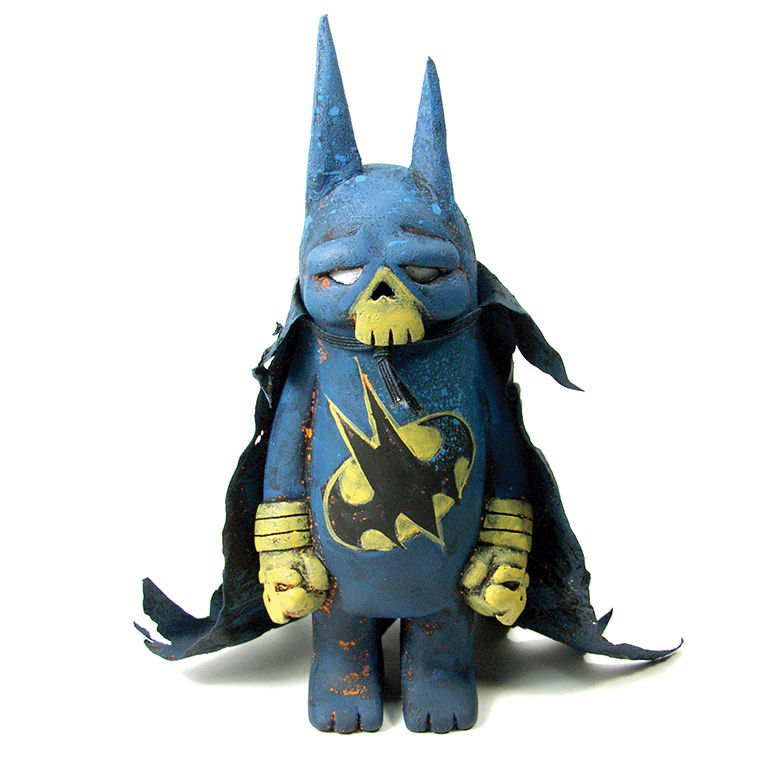Vinyl toy artistry makes way to United States
The “Bat Bear,” a customized vinyl bear champ toy, is a collaboration between artists JC Rivera and Leecifer. customized vinyl Bear Champ toy
March 30, 2015
When it comes to trends, it may seem like the U.S. is at the forefront of the scene, but that is not the case when it comes to vinyl toy art.
Vinyl toys have been one of the most popular art forms in Japan and China throughout the last 50 years, but they have only become popular in the U.S. in the last 15 years, according to vinyl artist Lee Gajda, also known as Leecifer.
Gajda is one of the featured artists in “For The Love of Toys,” the April 10 Galerie F exhibit, 2381 N. Milwaukee Ave., which will feature works from several vinyl artists, including Gajda, JC Rivera, JFury and Rocketboy. Gajda said many of his favorite artists began adopting the art form in the early 2000s, which showed a new side to their work.
“As the economy sort of changed and we cut back [on] buying big canvases, it was really cool to see some of my favorite artists having 3D representations of their work in the form of vinyl,” Gajda said.
JFury said he first got the inspiration for vinyl toy artistry when he took his children on a vacation to Disneyland a few years ago.
“I stumbled across the Vinylmation figures and thought the idea was great,” JFury said. “I loved seeing all these different artists put their stuff on the same platform. I went home after and did some research and found KidRobot and started doing some of these little figures that they produced.”
Vinyl toy artistry was a surprise for many of the artists in the show, such as featured artist Rocketboy, who needed a new hobby after his professional wrestling career was cut short because of a shoulder injury that forced him to retire.
“I was looking for something to do for a creative outlet and stumbled upon some vinyl toys online and was just enamored by what other artists were doing in the scene,” Rocketboy said. “I got to the point where I wanted to try it out myself.”
Both Rocketboy and JFury said they had no prior experience in the art form when they began. Through the close-knit community of artists, Rocketboy said he has been able to learn new techniques.
“The scene’s very friendly, so everyone’s been really supportive,” Rocketboy said. “If I have a question like, ‘How’d you get that effect?’ They would teach me and I would do my best to make it my own.”
Rivera, who is widely known throughout the city’s art scene for his signature character the Bear Champ, helped curate the upcoming show. Although a large number of Rivera’s pieces are done as customizable, factory-produced vinyl dummies, he said he prefers using resin sculpting because it is a more personalized process as opposed to the mass production of vinyl.
“It’s like the closest thing to vinyl, that if you do it right, it looks just like it,” Rivera said. “People will buy it or even pay more because it’s from you. You start from scratch. You sculpt it, make the mold, make the replicas and paint it yourself. We figured out as artists, if you know how to sculpt, that was the way you can have your own small production of toys.”
Gajda said the recent trend in the U.S. of using resin instead of the vinyl dummies has given many young artists a chance to showcase their own original designs, rather than relying on major vinyl companies to distribute their work.
“What’s nice about resin is that it’s the DIY aesthetic that comes out of the streets and punk music and the do-it-yourself zine culture that allows folks to do it themselves, whereas The Pickle Baby was literally thousands of dollars to have the molds made and have them pulled,” Gajda said. “Resin casting is relatively inexpensive. So, there’s kind of been this explosion.”
All of the art featured in the Galerie F display will be original pieces made specifically for the exhibit, and the show opens April 10.








